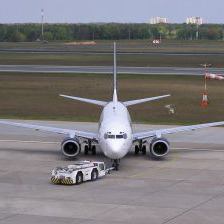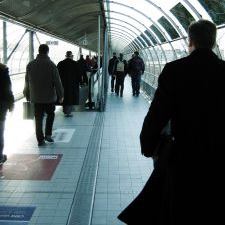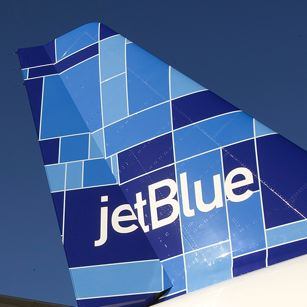 It should come as no surprise that the results of the 2009 J.D. Power North American Airline Satisfaction Study, which was just released today, show that passengers are anything but satisfied.
It should come as no surprise that the results of the 2009 J.D. Power North American Airline Satisfaction Study, which was just released today, show that passengers are anything but satisfied.
It’s been a tough year financially for airlines, and the strain has taken its toll on the flying public. The study reveals that survey respondents’ overall satisfaction with airlines has declined for a third consecutive year, hitting a four-year low.
The three categories that primarily drove the decline were in-flight services, flight crew, and costs and fees, all of which showed notable drops in customer satisfaction compared to last year.
“Tough times mean layoffs, fewer flights, and not as much in the way of food and service,” said Paula Sonkin, a vice president at J.D. Power and one of the survey’s directors.
But it isn’t all bad news. The study, which surveyed over 12,000 passengers flying on dozens of major U.S. and Canadian airlines over the last 12 months, did show that airlines had improved in some areas.
More Air Travel News:
- Air Travel Complaints On the Rise
- Which Airlines Can You Rely On?
- News Analysis: What American Airlines Says About the State of Aviation
- Airlines & Airports Travel News
Check-in and reservations procedures were rated more highly by respondents than they were last year, and customer-reported flight delays have been reduced by eight minutes compared to 2008.
On-time arrival rates also improved somewhat, despite the fact that airlines are widely believed to “pad” flight times with extra minutes to give them more wiggle room when it comes to being late.
 Sonkin argues that though some airlines might consider this, they would be hesitant to do so because listing a longer flight time would likely cause a potential passenger to choose a shorter flight advertised on another airline if he or she had a choice between two similarly priced tickets.
Sonkin argues that though some airlines might consider this, they would be hesitant to do so because listing a longer flight time would likely cause a potential passenger to choose a shorter flight advertised on another airline if he or she had a choice between two similarly priced tickets.
But despite the gains in some categories, the declines won out, as passengers sent a clear message that airlines need to do better.
“Unfortunately, any improvements in customer satisfaction are being offset by passenger displeasure with cutbacks on in-flight services, increases in fees and issues with the helpfulness and courtesy of flight crews,” said Dale Haines, senior director of the travel practice at J.D. Power.
Overall, leisure travelers were happier than business travelers, but only marginally so. Across all seven measures (cost and fees, flight crew, in-flight services, aircraft, boarding/deplaning/baggage, check-in, and reservations) leisure travelers gave airlines an average rating of 664 out of 1,000 possible points, while business travelers gave a score of 631.
 A more glaring gulf opens up when you compare traditional and legacy carriers with low-cost and budget airlines. Fliers gave traditional carriers (defined as airlines that operate multi-cabin aircraft and use multiple hubs) an overall score of 626 out of 1,000. However low cost and budget carriers (defined as those with single-cabin craft that typically offer lower fares) rated 726 out of 1,000.
A more glaring gulf opens up when you compare traditional and legacy carriers with low-cost and budget airlines. Fliers gave traditional carriers (defined as airlines that operate multi-cabin aircraft and use multiple hubs) an overall score of 626 out of 1,000. However low cost and budget carriers (defined as those with single-cabin craft that typically offer lower fares) rated 726 out of 1,000.
For the second year in a row, Alaska Airlines came out on top in the traditional carrier category, while JetBlue topped the low-cost carrier segment for the fourth year running. JetBlue also came out first overall, with a total score of 750 out of 1,000.
JetBlue performed well in the aircraft and in-flight services categories, while Alaska did well in the flight crew, aircraft, boarding/deplaning/baggage, check-in, and reservation categories.
For more on Alaska travel, check out Sarah Palin Vacations: From Snow Machines to Moose Hunting, Travel Like a Palin in Alaska.
“Their philosophy seems to be one of courtesy and customer service,” Sonkin said of Alaska, when asked why travelers rated the airline so highly. “People are looking for airlines to be respectful of their time,” she continued, and Alaska seems to have mastered that.
The “most improved” award goes to Southwest, which was the only airline in the study to actually show overall improvement compared to 2008. Their score went up by eight points this year, while all other airlines’ scores went down by between 15 and 40 points.
At the bottom of the pile was US Airways, which not only was the lowest-scoring traditional carrier, but the lowest-scoring of all 13 airlines surveyed. Furthermore, its score of 599 represents a 41-point drop from 2008.
More US Airways News:
- Blaming Bad Publicity, US Airways Drops Beverage Fees
- US Airways, Virgin, Other Airlines Laying Off Thousands
- Recession Taking a Bite Out of International Air Travel
- As Other Airlines Struggle, AirTran Posts Q1 Profit
WestJet, the Canadian budget airline, did well in its first year in the survey. With an overall score of 736, it tied for second place in both the low-cost carrier segment and the overall rankings.
By Karen Elowitt for PeterGreenberg.com.
So what do you think? Did JD Power get it right? Let us know in the comments.












